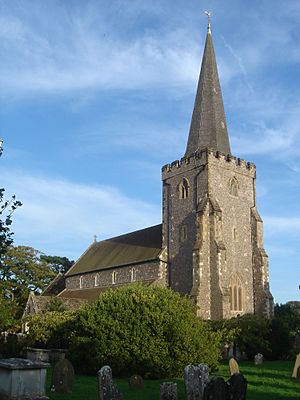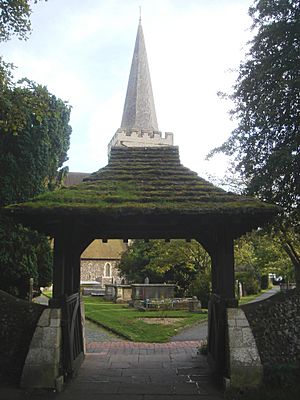St Andrew's Church, West Tarring facts for kids
Quick facts for kids St Andrew's Church |
|
|---|---|

The church from the northwest
|
|
| 50°49′29″N 0°23′45″W / 50.8247°N 0.3958°W | |
| Location | Church Road, West Tarring, Worthing, West Sussex BN13 1HQ |
| Country | England |
| Denomination | Church of England |
| Website | Saint Andrew's Parish Church, West Tarring |
| History | |
| Status | Parish church |
| Founded | 11th century |
| Founder(s) | Archbishop of Canterbury |
| Dedication | Saint Andrew |
| Dedicated | By 1372 |
| Architecture | |
| Functional status | Active |
| Heritage designation | Grade II* |
| Designated | 11 October 1949 |
| Style | Perpendicular Gothic |
| Administration | |
| Parish | West Tarring, St Andrew |
| Deanery | Rural Deanery of Worthing |
| Archdeaconry | Chichester |
| Diocese | Chichester |
| Province | Canterbury |
St Andrew's Church is a historic Church of England church located in Tarring, West Sussex, England. It was first built in the 11th century, a very long time ago! For many years, it was special because it belonged directly to the Archbishop of Canterbury. This church helped other nearby towns when their own churches were not in good shape. A famous person named John Selden was even baptized here. The church building you see today is mostly from the 13th century, and its tall spire is a well-known sight in the area. St Andrew's Church is recognized as a Grade II* Listed Building, meaning it is very important.
Contents
A Look Back: Church History
The area of West Tarring is now part of Worthing. But it started as a small, ancient parish. It stretched from the South Downs hills all the way to the English Channel coast. This shape was common for coastal parishes in Sussex. It meant they had different types of land, from chalky hills to marshy areas. Two main settlements grew here, with West Tarring being the larger one.
Early Days of the Church
The first time West Tarring was written about was around AD 939. At that time, King Athelstan gave the land of Tarring to Canterbury Cathedral. In 1086, when the Domesday Book was created, the Archbishop of Canterbury still owned it. There were 41 people living there. We know a church existed then, likely made of wood.
The stone church building we see today began to be built in the mid-13th century. Around that time, the church's leader, Simon of Tarring, gave shelter to Richard of Wych. Richard later became Saint Richard of Chichester. He was the new Bishop of Chichester but was not allowed into his own palace by King Henry III. While staying at St Andrew's, Richard traveled around Sussex, leading services and people believed he performed miracles. He became a saint in 1262.
Changes Over Time
The church was first called St Andrew's in 1372. In the 15th century, parts of the church, like the chancel and tower, were rebuilt. This was likely influenced by Canterbury. The wooden screen inside the church, called a rood screen, also dates from this time.
The church wasn't very rich. To raise money for its upkeep, people held "church ales." These were events where church leaders sold beer to raise funds. They were popular in the 16th century and often involved lots of food and entertainment.
An organ was put in the church in the late 16th century. Bells were added to the tower by 1518. By 1533, there were five bells. These bells were made by the Tapsel family, who had a bell foundry near the church. The Tapsels made many bells for churches across Sussex for about 200 years. They also invented the Tapsel gate, a special type of gate found in some Sussex churchyards.
Helping Other Parishes
For a long time, the nearby areas of Durrington and Heene were connected to West Tarring. Their church taxes were combined, and St Andrew's handled their church services. By the 17th century, the churches in Durrington and Heene were in ruins. So, people from those areas were allowed to come to St Andrew's for worship instead.
Victorian Era Changes
Big changes happened in the mid-19th century. In 1845, St Andrew's Church became part of the Diocese of Chichester, like other churches in the area. In 1853, the vicar (the church's leader) started a major restoration project. He raised most of the money himself. During this time, a wooden gallery was removed, a new room for the clergy was added, and the inside of the church was completely updated. The organ was also replaced.
In 1853, four of the church bells were recast into a new set of six. The restoration took seven months and was finished in time for Easter in 1854. Later, in 1885, beautiful mosaics were added to the aisles and around the tower arch. These were designed by a famous architect named William Butterfield. The church roof also needed repairs around this time. In the 20th century, a special gate called a lychgate was built at the churchyard entrance. The altar screen was replaced, the organ was replaced again, and new stained glass windows were added.
The Missing Font
The church's old font was replaced with a new one during the Victorian era. The main part of the old medieval font was taken to Australia by the Henty family when they moved there. The Hentys were successful farmers, especially of merino sheep. They lived in one of West Tarring's biggest houses. The family eventually moved to Australia, and they gave the old font to a cathedral in Melbourne. Some say it was St Patrick's Cathedral, Melbourne, while others say it was St Paul's Cathedral, Melbourne. Interestingly, the architect of St Paul's Cathedral, William Butterfield, had also worked at St Andrew's Church.
A Secret Past: Smuggling
Between the early 18th and early 19th centuries, smuggling was common in the Worthing area. One of the main people involved in smuggling at that time was William Cowerson. He actually worked on the restoration of St Andrew's Church! He often used the stone tombs in the churchyard to hide smuggled goods.
Church Building and Design
St Andrew's Church is built in the Early English Gothic style, with some parts showing the Perpendicular Gothic style. It is made of flint and stone. It's quite large compared to other churches nearby, probably because of its connection to Canterbury.
Inside the Church
The main part of the church, called the nave, is from the 13th century. It has five sections with side aisles, and a row of windows high up called a clerestory. There are also porches on the north and south sides. The windows are tall and narrow, typical of the Early English style.
The chancel (the area around the altar) and the tower were rebuilt in the 15th century in the Perpendicular style. The tall, eight-sided spire on top of the tower was added in the 16th century. The chancel has windows with two sections. Some of the tower windows look more like the earlier Decorated Gothic style. The large east window in the chancel is very fancy. It has a tall central window with smaller ones on each side, and six-lobed circular openings at the top.
Inside, the nave has five pointed arches on each side. These arches rest on round columns with decorative tops. The mosaic decoration, which shows the Twelve Apostles, runs between and above these arches. The arch leading to the chancel was restored in the mid-19th century. The 15th-century screen in the chancel was kept during the 1853 renovations. The chancel also has six special seats called misericords, two of which have carved heads.
Memorials and Windows
There are several memorials inside the church. The Henty family is remembered with a stone tablet and a 19th-century window near the altar. There is also a window for Robert Southey, a famous poet. He was the father-in-law of the vicar who restored the church in the mid-19th century. The most famous person connected to St Andrew's Church is John Selden. He was baptized here in 1584, and there is a memorial and a plaque for him.
Windows made by Paul Chapman of Cox & Barnard were installed in 1958. They show Saint Thomas of Canterbury and Saint Richard of Chichester.
St Andrew's Church Today
St Andrew's Parish Church has been a Grade II* Listed Building since October 11, 1949. This means it is considered "particularly important" and "of more than special interest." As of February 2001, it was one of eight Grade II* listed buildings in the area of Worthing.
Today, the church's parish is smaller than it was long ago. However, it still includes the northern part up to Salvington. Its other boundaries are the railway line to the south, The Boulevard to the west, and a line west of Loxwood Avenue to the east.
See also


